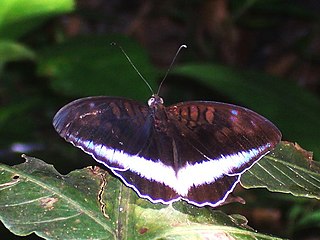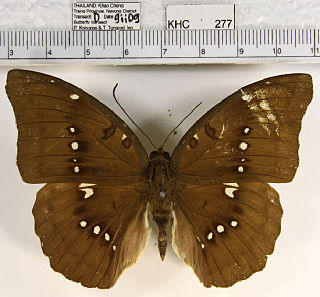
Vanessa atalanta, the red admiral or, previously, the red admirable, is a well-characterized, medium-sized butterfly with black wings, red bands, and white spots. It has a wingspan of about 2 inches (5 cm). It was first described by Carl Linnaeus in his 1758 10th edition of Systema Naturae. The red admiral is widely distributed across temperate regions of North Africa, the Americas, Europe, Asia, and the Caribbean. It resides in warmer areas, but migrates north in spring and sometimes again in autumn. Typically found in moist woodlands, the red admiral caterpillar's primary host plant is the stinging nettle ; it can also be found on the false nettle. The adult butterfly drinks from flowering plants like Buddleia and overripe fruit. Red admirals are territorial; females will only mate with males that hold territory. Males with superior flight abilities are more likely to successfully court females. It is known as an unusually calm butterfly, often allowing observation at a very close distance before flying away, also landing on and using humans as perches.

Symphaedra nais, also known as the baronet, is a species of Nymphalid butterfly found in South Asia. It was formerly included in the genus Euthalia but it is a sister to members of the genus Bassarona.

The Limenitidinae are a subfamily of butterflies that includes the admirals and relatives. The common names of many species and genera reference military ranks or – namely the Adoliadini – titles of nobility, in reference to these butterflies' large size, bold patterns, and dashing flight. In particular, the light stripe running lengthwise across the wings of many Limenitidini has reminded earlier authors of officers' shoulder marks and epaulets.

Athyma selenophora, the staff sergeant, is a species of nymphalid butterfly found in tropical and subtropical Asia.

The Satyrini is one of the tribes of the subfamily Satyrinae. It includes about 2200 species and is therefore the largest tribe in the subfamily which comprises 2500 species.

Hypolimnas misippus, the Danaid eggfly, mimic, or diadem, is a widespread species of nymphalid butterfly. It is well known for polymorphism and mimicry. Males are blackish with distinctive white spots that are fringed in blue. Females are in multiple forms that include male-like forms while others closely resemble the toxic butterflies Danaus chrysippus and Danaus plexippus.

Neptis soma, the sullied sailer or the creamy sailer, is a species of nymphalid butterfly found in south and southeast Asia.

Euthalia lubentina, the gaudy baron, is a species of nymphalid butterfly found in South, Cambodia, and Southeast Asia. It was first described by Pieter Cramer in 1777.

Neptis columella, the short banded sailer, is a species of nymphalid butterfly found in South and Southeast Asia.

Euthalia is a genus of brush-footed butterflies. They are commonly called barons or dukes.

Melanitis zitenius, the great evening brown, is a species of nymphalid butterfly found in Asia. The species is crepuscular.

Kallima inachus, the orange oakleaf, Indian oakleaf or dead leaf, is a nymphalid butterfly found in Tropical Asia from India to Japan. With wings closed, it closely resembles a dry leaf with dark veins and is a commonly cited example of camouflage.

Cirrochroa thais, also known as the Tamil yeoman, is a species of nymphalid butterfly found in forested areas of tropical Sri Lanka and India. It is the state insect of Tamil Nadu, an Indian state.

Herona marathus, the pasha is a species of nymphalid butterfly found in India.

Bassarona durga, the blue duke, is a species of nymphalid butterfly found in the Himalayas.

Bassarona teuta, the banded marquis, is a species of nymphalid butterfly.

Bassarona dunya, the great marquis, is a butterfly of the family Nymphalidae. It is found in South-East Asia.

















